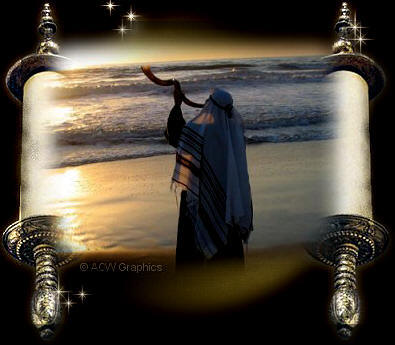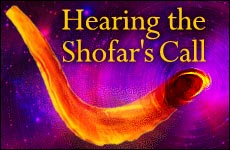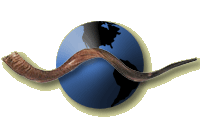Prophetic Information
Resource
Center
|
|
|
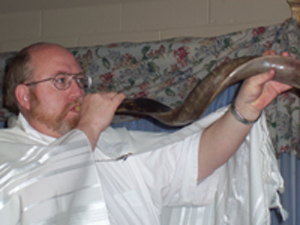 The Shofar The Shofar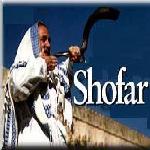
There
are two kinds of trumpets used in the Bible. The ram's horn, which is the
"Shofar" (sho-far) and the silver trumpets. The "shofar"(Hebrew), the ram's horn
is a musical instrument of antiquity - of God's own making! The silver trumpet
was made by man and was used by special people - the priests. The Lord
instructed Moses to make two silver trumpets (Number 10). The first silver
trumpet was appointed for the calling forth of the assembly and the other for
the mobilization of the camp when they were about to journey. Thus the first was
to gather the people together while the second trumpet meant it was time to
"move forward". The silver trumpet is not used today but will play a big part in
end times. Today a longer shofar is also used and this is called a Yemenite
Shofar. It comes from the African antelope known as the Kudu. I am not sure if
this kind of shofar was used in Biblical times. This long shofar is very popular
today. Many people are misled and think that the long shofar is more powerful
and can make a bigger sound than the smaller ram's horn. It is not about the
size, or bigger blast.
From the Hebrew we see the following:
horn, ram's horn     showphar {sho-far} or shophar {sho-far} Strongs #7782 - a trumpet made from a curved animals horn, a cornet. showphar {sho-far} or shophar {sho-far} Strongs #7782 - a trumpet made from a curved animals horn, a cornet. |
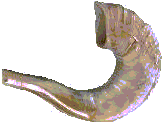 |

trumpet,
clarion      chatsots@rah {khats-o-tser-aw} Strongs # 02689 - a silver trumpet
blown by the priests and made by man. chatsots@rah {khats-o-tser-aw} Strongs # 02689 - a silver trumpet
blown by the priests and made by man.
Our English Bible used the word
trumpet for both, the ram's horn and for the silver trumpet. In most cases it
refers to the ram's horn. In some cases it refers to the silver trumpet. In the
following scripture we will see how the Bible refers to them both. "With
trumpets and the sound of a horn; shout joyfully before the Lord, the
King."(Psalm 98:6). The ram's horn is called the shofar and the silver trumpet
called "Tzotz-rot" or "khats-o-tser-aw". The ram's horn and the silver trumpet
are two different instruments with different uses. The shofar is not a musical
instrument but was used as a ceremonial instrument.
The shofar is a
symbol of power. The natural weapon of animal is their horns on their head. The
horn is an animal's source of power, its physical strength. It is used to cause
damage to its enemy. The horns are very strong and animals normally have a pair
of horns. When male animals fight to be the dominant male of a herd, they fight
against each other using the horns. Sometimes a horn or part of it will break
off or get damaged, during these battles. Sometimes it will penetrate the body.
You can hear the sound of the horns connecting each other far away. The
strongest male always wins. Only when you see a fight like this you realize how
strong these horns of an animal can be. The ram's horn was normally from goats,
or from another antelope known as the Oryx. Horns of cattle were not used for
shofars because they were used as the image of Baal.
The shofar is a
Hebrew word that comes from a root word which, means beauty. Shofar is
translated as a "sense of incising". This means to "cut" or "burn into". The
sound of the shofar is more than just a blast of air through the horn or a flow
of air through the horn. The name "shofar" signified a cutting or burning into
the heart and soul of man. Even today hearing the sound of the shofar penetrates
deeply into the spirit and soul. Upon listening to the sound of the shofar the
soul is meant to be motivated to purify it before God. It is also important to
take note that a horn was on each corner of the Altar of Burnt Offering (Exodus
27:1-8) and also on each corner of the Altar of Incense (Exodus 30:1-10).
The shofar has many uses in the Bible. It was used:
For announcing
the coming of the Lord
For warning people
For praise and worship
For
announcing a feast
For warfare
For victory in a battle
For
assembling the community or nation
For the coronation of a king
For
calling the angels to assist (Gideon in Judges 6:33)
The shofar's
purpose was to blow it but it was also used to hold oil as we see in 1 Sam 16:1
and 1 Kings 1:39. Today the shofar is blown prior and during the High Holy Days
of the Jews. On Rosh Hashanah, the Jewish New Year the shofar is blown 101
times. On Yom Kippur (Day of Atonement) the shofar is blown at the end of the
prayer service. The three different sounds or blasts that we can hear during
this period:-
- The Tekiyah - which means "blast" is one continuous long
blast. It is a sound of triumph, joy and happiness.
- The Shevarim - This means "broken". It consists of three
shorter blasts. This represents a broken moaning sound signifying that we are
broken before the Lord.
- The Teruah - This means "alarm". It is a set of nine short
blasts. This is an uttering of short piercing cries, a plea for mercy.
We first read about the ram's horn when
Abraham was about to sacrifice Isaac. The Lord provided a ram. "And Abraham
lifted up his eyes and looked and there behind him was a ram caught in a thicket
by his horns. So Abraham went and took the ram and offered it up for a burnt
offering instead of his son". (Gen 22:13). This ram was caught by its strength,
the horns. Interestingly we also read that a ram must be binded to it's horns if
it resist to be a sacrifice (Psalm 118:27). This ram was used as the sacrifice.
From then on the ram's horn has become a symbol of God's covenant and His
redemption. We also see that four animal horns were placed on the corners of the
Altar of Burned Offering and the Altar of Incense in the Tabernacle.
Animal horns are made of cartilage (fleshly bone), blood and keratinous
material (similar to fingernails). The cartilage is removed and a hole is
drilled at the small end or tip for the air to flow through. But it is still
rough inside and small portions of flesh still remains behind. The rough edges
need to be smoothed on the inside. The remaining flesh needs to be removed. This
allows the air to pass through much easier without hindrance and it gives a
special sound when blowing the shofar. This is symbolic of man. We to must
remove the flesh from our lives. The breath of God (Holy Spirit) brings us into
obedience. All the rough edges need to be removed in order for us to be an
effective instrument of God. Initially the new shofar has a terrible smell or
odor because of the residue of flesh that is still remaining within it. This
needs to be removed and cleaned, in order to get rid of the rotten smell. This
is also revelant to man. When we are reborn we still have that flesh nature in
us. This needs to be removed before we can become a sweet fragrance to other
believers. A special process removes this remaining flesh inside the shofar.
Small stones are mixed with salt and poured into the shofar. Both open ends are
then capped and then the shofar is shacked from side to side until all flesh is
removed. This also cleans the horn on the inside. This process is repeated
several times and it also needs to be done from time to time again. We as
believers are also shaken at times to remove the lingering vestiges of flesh in
us. The small stones are normally hard and this symbolizes the hard trials and
tribulations that we need to go through for the purification process. Referring
to the salt. We read in Mark 9:49 that every sacrifice will be seasoned with
salt. This is the sacrifice of our flesh which is also referred to in Gal 5:24.
"And those who are Christ's have crucified the flesh with its passion and
desires".
Many believers and owners of shofars do not know the above and
do not know and see the significance of the shofar. Many believers bought
"shofrot" (shofars) that do not require the above procedures and we cannot
identify with above. These "shofrot" (shofars) went already through this
preparation phase and we do not have to do anything. It is already done for us.
Many "shofrot" (shofars) looks magnificent, beautiful, polished and have
beautiful and great sounds. This needs to speak to us spiritually in our
preparation to be a great instrument in God's hand.
Summary: The
"shofar" is illustrative of the following:
- Of power of God
Ps 18:2; Hab 3:4
- Of power of Christ
Luke 1:69; Rev 5:6
- Of power of Ephraim
Deut 33:17
- Of power of the wicked
Ps 22:21; Ps 75:10
- Of kings
Dan 7:7,8,24; Dan 8:3,5,20
- Of anti-Christian powers
Rev 13:1; Rev 17:3,7
- (Budding of) the commencement or revival of a nation
Ps 132:17; Ezek 29:21
- (Raising up,) of arrogance
Ps 75:4,5
- (Exalting,) of increase of power and glory
1 Sam
2:1,10; Ps 89:17,24; Ps 92:10; Ps 112:9
- (Pushing with,) of conquests
Deut 33:17; 1 King 22:11;
Mic 4:13
- (Bringing down,) of degradation
Job 16:15
- (Cutting off,) of destruction of power
Ps 75:10; Jer
48:25; Lam 2:3
|
|
|
|
|
|
|
|
|
|

